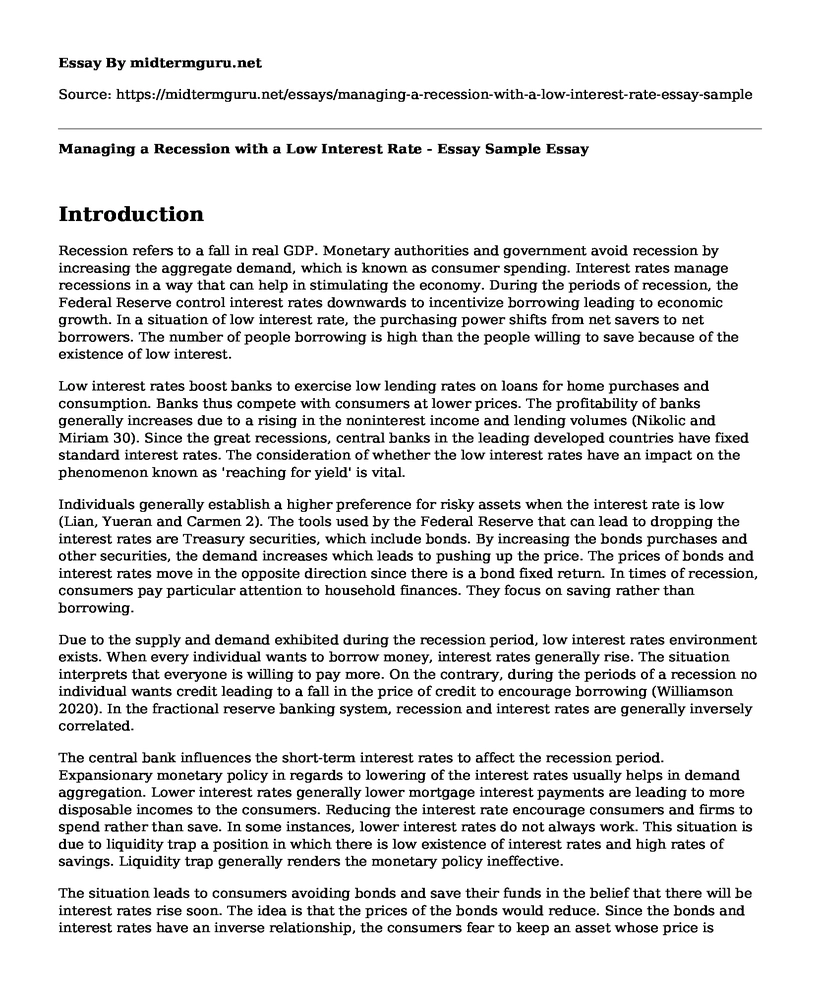Introduction
Recession refers to a fall in real GDP. Monetary authorities and government avoid recession by increasing the aggregate demand, which is known as consumer spending. Interest rates manage recessions in a way that can help in stimulating the economy. During the periods of recession, the Federal Reserve control interest rates downwards to incentivize borrowing leading to economic growth. In a situation of low interest rate, the purchasing power shifts from net savers to net borrowers. The number of people borrowing is high than the people willing to save because of the existence of low interest.
Low interest rates boost banks to exercise low lending rates on loans for home purchases and consumption. Banks thus compete with consumers at lower prices. The profitability of banks generally increases due to a rising in the noninterest income and lending volumes (Nikolic and Miriam 30). Since the great recessions, central banks in the leading developed countries have fixed standard interest rates. The consideration of whether the low interest rates have an impact on the phenomenon known as 'reaching for yield' is vital.
Individuals generally establish a higher preference for risky assets when the interest rate is low (Lian, Yueran and Carmen 2). The tools used by the Federal Reserve that can lead to dropping the interest rates are Treasury securities, which include bonds. By increasing the bonds purchases and other securities, the demand increases which leads to pushing up the price. The prices of bonds and interest rates move in the opposite direction since there is a bond fixed return. In times of recession, consumers pay particular attention to household finances. They focus on saving rather than borrowing.
Due to the supply and demand exhibited during the recession period, low interest rates environment exists. When every individual wants to borrow money, interest rates generally rise. The situation interprets that everyone is willing to pay more. On the contrary, during the periods of a recession no individual wants credit leading to a fall in the price of credit to encourage borrowing (Williamson 2020). In the fractional reserve banking system, recession and interest rates are generally inversely correlated.
The central bank influences the short-term interest rates to affect the recession period. Expansionary monetary policy in regards to lowering of the interest rates usually helps in demand aggregation. Lower interest rates generally lower mortgage interest payments are leading to more disposable incomes to the consumers. Reducing the interest rate encourage consumers and firms to spend rather than save. In some instances, lower interest rates do not always work. This situation is due to liquidity trap a position in which there is low existence of interest rates and high rates of savings. Liquidity trap generally renders the monetary policy ineffective.
The situation leads to consumers avoiding bonds and save their funds in the belief that there will be interest rates rise soon. The idea is that the prices of the bonds would reduce. Since the bonds and interest rates have an inverse relationship, the consumers fear to keep an asset whose price is expected to decline. Liquidity trap according to Keynes' is a situation where individuals prefer non-liquid money forms instead of bonds. This preference generally leads to a significant decrease in the bonds prices and a consequent yield increment.
Nevertheless, individuals' desire cash no matter the yield price increase of the bonds. Many economists worldwide have doubted the central bank monetary policy impact since the end of the great recession. The long easy monetary policy, which is implemented by central banks, forms the basis of significant criticism of lower interest rates. Since the recession, the monetary policy has left the interest rates at almost zero levels.
Works Cited
Lian, Chen, Yueran Ma, and Carmen Wang. "Low interest rates and risk taking: Evidence from individual investment decisions." Review of Financial Studies (2018). https://papers.ssrn.com/sol3/papers.cfm?abstract_id=2809191
Nikolic, Marko, and Miriam Homsi. "Negative Interest Rates Effect Economic Stability." (2018)
http://www.diva-portal.org/smash/get/diva2:1247417/FULLTEXT01.pdf
Williamson, Stephen D. "Low real interest rates, collateral misrepresentation, and monetary policy." American Economic Journal: Macroeconomics 10.4 (2018): 202-33.
https://www.sciencedirect.com/science/article/pii/S0304393218303805
Cite this page
Managing a Recession with a Low Interest Rate - Essay Sample. (2022, Dec 21). Retrieved from https://midtermguru.com/essays/managing-a-recession-with-a-low-interest-rate-essay-sample
If you are the original author of this essay and no longer wish to have it published on the midtermguru.com website, please click below to request its removal:
- Answers to Questions About Auditors Liability and Independence
- Report on Canyon Creek Food Company Ltd
- Essay on Insurance Companies and Health Care Organizations
- Paper Example on International Financial And Banking
- Digital Banking's Transformation to Omni-Channel: A Necessary Evolution - Essay Sample
- Human Resources: More Than Hiring & Firing - Essay Sample
- Employee Rights Protected by Labor Laws - Research Paper







